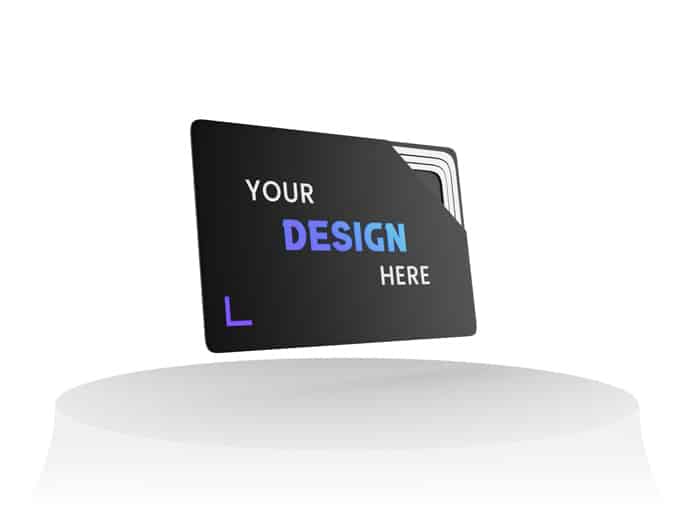
Business cards and waste: how to avoid it?

In this article, we’ll try to shed some light on this issue and answer the various questions as precisely as possible.
The two ways of distributing business cards!
Yes, most of the time, there are two ways of sharing business cards: when I meet someone who needs my contact details, for example at a trade show or cocktail party, or by leaving them out in large numbers in a waiting room, at the entrance to a store or in the lobby of a company.
While the former is useful in enabling someone to get back to you easily, the latter generally produces very few concrete results and is, above all, a huge waste.
In the age of the Internet, it’s a mistake to think that leaving business cards in one or more places will bring customers to you.
In the same way that a flyer becomes invisible among others, your business card will be drowned among those of your competitors, and there’s a good chance that it will end up being thrown away by the venue manager when the pile gets too big!
What if I drop the business card directly into a letterbox?
You’d think that this time you’d avoid the risk of your business card getting lost among the others. However, the problem is almost the same, as your business card is likely to get stuck between advertising leaflets or letters and end up being discarded without even being looked at: once again… an ecological waste!
Is it possible to recycle a printed business card?
Indeed, the question arises as to whether easy recycling of business cards might not be a good solution?
The answer is obvious: nothing beats a printed medium that can be easily recycled.
But that doesn’t solve the problem of waste, i.e. the fact that the medium is thrown away without even taking the time to consider the information it contains.
What’s more, we’d like you to be aware of the difference between a recyclable business card and one made from recycled materials: they’re not the same thing at all, even if the words sound alike!
A business card whose base material is recycled does not imply that it can be recycled without producing waste!
This is a point to which you need to pay close attention and, to avoid an excessive ecological footprint, it’s best to choose a genuinely recyclable business card.
Avoid the trap of sliding-scale prices for large-scale business card printing
Economically speaking, you might think it’s a good idea to order a large number of printed business cards, because then the unit price becomes very low.
However, this is a trap for two reasons: the first is that you run the risk of leaving your cards all over the place, and because they’re so inexpensive, you may subconsciously think that this is a good way of sharing information: you’ll end up with what we described above, i.e. a lot of waste for almost no efficiency.
The second reason is that changes may occur, such as a change in your company’s address, a change in business activity, or simply a change of telephone number: in this case, your stock of paper business cards will become obsolete, and you’ll be forced to throw them away and possibly print a new batch of cards.
In this case, the waste is obvious.
How about eco-friendly printing?
Business card manufacturers and printers have obviously been asking themselves how to reduce their ecological footprint for several years: today, for example, you’ll find models made from paper pulp sourced from more sustainably managed wood resources (“FSC” certification).
This reduces energy consumption by around 60%, and water consumption by as much as 70%.
As far as printing inks are concerned, it is now possible to create colorants with natural pigments and water-based solvents, rather than derivatives derived from petroleum products.
Nevertheless, even if the eco-business card itself is less costly in terms of energy and natural resources, if it ends up being thrown away unused, it’s still a form of pointless waste…
Does information on paper still have a future?
Yes, it’s not a question of generalizing and saying that all printed information is obsolete. But as far as business cards are concerned, we can see that the vast majority of people who need to obtain contact details for a company or professional turn to the Internet to get them.
And since voice recognition has made enormous strides, more and more people are asking their smartphones directly for the information they need: no need to type what you want on a virtual keyboard, just dictate it!
It’s so convenient that we no longer bother to decipher the contact details on a business card.
And this trend is set to continue!
Surveys carried out among a wide range of users show that they expect control interfaces to be increasingly dematerialized, yet simple and efficient in their operation: asking your computer or smartphone for the information you want, and getting an almost instant response, meets people’s needs!
An emerging ecological awareness, even among professionals and within companies!
It’s an undeniable fact: respect for the environment and the desire to take a more respectful approach to natural and energy resources are making inroads at all levels of society, and particularly in the professional world.
From this point of view, paper and printed business cards are increasingly perceived as a useless communication accessory, due to the manufacturing chain they require: wood resources, cardboard conversion, use of more or less chemical inks, printing, cutting, packaging, delivery….
Clearly, the current trend is towards a clear reduction in this means of communication.
Since a company’s brand image is an integral part of its “DNA”, an environmentally-friendly approach is a direction in which more and more managers wish to engage.
How to avoid wasting business cards?
There’s a simple solution that’s proving increasingly popular: the digital business card.
It looks like a traditional business card, with a similar format, but features a QR Code and an NFC chip that automatically transmits the information to your contact’s smartphone.
So all you need to do is have your digital business card made once, and you can use it as often as you like to exchange contact details.
It’s really practical, and the ecological footprint is reduced to a minimum.
But there’s another considerable advantage: you can update the information very easily, since it’s stored on a server.
If you want to change a phone number or address, simply log on to the server and make the change: immediately, the information you’ll be transmitting from now on will be updated.
Last but not least, the price of just a few dozen euros is very affordable, making it easy for any company to equip itself with this modern, efficient means of communication.
There’s a simple solution that’s becoming increasingly popular: the digital business card.
Similar in format to a traditional business card, it features a QR Code and an NFC chip that automatically transmits information to your contact’s smartphone.
So all you need to do is have your digital business card made once, and you can use it as often as you like to exchange contact details.
It’s really practical, and the ecological footprint is reduced to a minimum.
But there’s another considerable advantage: you can update the information very easily, since it’s stored on a server.
If you want to change a phone number or address, simply log on to the server and make the change: immediately, the information you’ll be transmitting from now on will be updated.
Last but not least, the price of just a few dozen euros is very affordable, making it easy for any company to equip itself with this modern, efficient means of communication.
Written by Camille BODET
The digital business card is a real ally for professionals wishing to promote their business effectively and instantly. In the...Lire la suite
VKARD is an innovative and effective solution to help all professionals stand out from the crowd and reinforce their brand...Lire la suite
If you prepare properly for a job interview, you'll have every chance of winning over the recruiter and getting the...Lire la suite
LinkedIn is a world-renowned business platform, and for good reason! Thanks to its many networking options, LinkedIn is the tool...Lire la suite
Find out how Leexi AI optimizes the management of videoconferences and business calls, saving time and improving efficiency.
In the professional sphere, it's vital to know how to convey certain strong values in order to stand out and...Lire la suite
Mastering the art of conversation is a real asset! By mastering the subtle art of conversation, you'll be able to...Lire la suite
Are you taking part in a trade event and want to do everything you can to make a good impression?...Lire la suite
CRM (Customer Relationship Management) represents a genuine corporate strategy for managing business contacts. This popular tool for professionals is in...Lire la suite
At a time when the professional world is in a perpetual state of competition, we might wonder what place altruism,...Lire la suite















